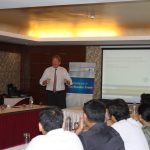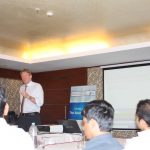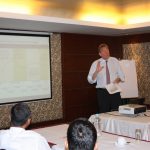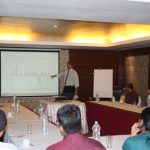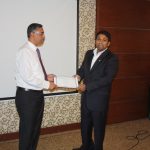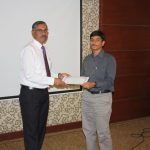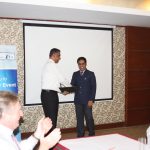- May 11, 2013
- Posted by:
- Category:BLOG, Events, Speaker Events
The Indian Association of Investment Professionals (IAIP) Bangalore community witnessed one of the most enlightening knowledge and experience sharing sessions presided by Paul Smith, the Managing Director of the Asia Pacific Region at the Chartered Financial Analyst (CFA) Institute. The session covered various topics such as the evolution, unique characteristics, challenges and operations of the Asian Hedge Funds Industry (the Industry) for various hedge fund activities such as distribution of products, product management, seeding and management fees. Paul also highlighted the role of CFA charter holders in this industry and emphasized that this business is like a “seductive dream”, creating an illusion of making good money, but in reality, he believes that the odds of making money is just one in twenty five.
The conference commenced with asynopsis of the life cycle of a typical Asian hedge fund.
- Most funds are small in nature, managing asset worth $50.0 million.
- The typical mortality rate for a majority of the firms is around 5 years. In the current global scenario, where liquidity of funds is weak, mortality rate is around 3 years.
- The management fee structure is 2.0 percent of total asset managed and 20.0 percent performance fees. Most of small time players find it difficult to manage the profitability of the firm. To explain, a $50.0 million fund would earn a management fee of $1.0 million. The amount of expenses incurred for the fund in the nature of travel, employee compensation, infrastructure, networking etc. would normally be higher than the fees unless the firm is able to achieve a significantly high return than the promised return.
- Most funds are created by individuals who have worked in the investment banking industry, having earned money to the tune of around $40.0 million. These individuals contribute about 75.0 percent of the total capital for the firm and the rest comes from family and friends. One important characteristic feature of this firm is that these firms have limited ability to scale-up. Further, these firms face liquidity crunches prior to the maturity of investments considering a small working capital, forcing the firm to liquidate its key holdings before the maturity of its investments, resulting in an inability to unlock the true potential of the firm, impacting profitability.
Paul provided a detailed overview of the Industry in terms of the size, unique characteristics, challenges evidenced & the current scenario. A few important points are discussed here.
Size of the Industry:
- The Asian Hedge Funds Industry is estimated to manage $138 billion in assets as compared to the $2.2 trillion worth of assets managed by the global hedge fund industry. The Industry has faced significant challenges since the latest global economy meltdown in 2008, when the Asian funds managed about $200 billion in assets.
- About 80 percent of the global assets of $2.2 trillion are managed by 5.5 percent of the firms, whereas 0.15 percent of the global assets are managed by 57.0 percent of hedge funds.
Unique Characteristics:
- Asian funds are more liquid in nature. This can be evidenced by the fact that more than 50.0 percent of the funds are long – short in nature.
- Asian funds focus on building their assets typically through exposures in equity whereas funds in North America (N.A.) and Europe have historically focused on fixed income.
- The firms depend on the West for funds. About 80.0 percent of the funds managed in Asia are sourced from N.A. and Europe. The major implication is that any liquidity crisis in N.A. & Europe would first trigger a sell-off in these Asian funds. Of late, the Industry has evidenced significant redemption and this has resulted in a debt spiral and a shortfall in liquidity.
- Most Asian investors prefer to invest in the N.A. or Europe based hedge fund, though a shift is seen with certain investors in countries such as China.
Challenges:
- Between 2003 and 2012 Asian hedge funds returns did not outperform long only funds or their American and European counterparts. This has amplified the pressure on Asian fund managers to take risk and provide a higher return to institutional investors.
- The changing tax structure and regulations in countries like India have had an adverse impact on the investor confidence and has moved funds away from developing nations.
The current scenario:
- The cost of funds has increased significantly considering the introduction of stringent regulations for asset management firms globally.
- Most of the Asian fund managers have closed shop as they were tired of running this business in the current global scenario.
- The situation since the crisis in 2008 has not improved and the net inflows into Asia have been insignificant. The only funds that have been successful in attracting funds from global institutional investors are the long-only funds.
- The enhanced emphasis of risk management has had an upward revision on the cost of managing a firm. A typical firm now requires employees for trading, trade settlement and risk management apart from the fund manager team.
Paul predicts that more Asian funds would collapse in the next 5 years and greater consolidation can be evidenced in the years to come. He also provided insights of the performance of the Fund of Hedge Funds (FOHFs) in Asia. The total global assets managed by the FOHFs are currently $650.0 billion. These funds have collapsed in Asia since 2008 and currently there are about 5 firms which manage such funds on account of a change in business dynamics for FOHF. A few such changes are:
- The significantly high cost for investing in these funds – the total fee is typically around 5.0 percent of the funds managed.
- The lack of investor / institutional interest – investors are directly going to the product providers. Firms have adapted to this by now providing advisory or consulting services their clients.
Paul advised candidates and CFAs, especially professionals in their mid-career, to avoid the Industry considering the odds of success is very low and that people very easily get sucked into in. Paul suggested that the CAIA course would provide a practical grounding on the working of funds for those who envision the hedge fund industry as a career. For entrepreneurs who have a vision of starting their own fund, he suggested that they should have their strategy very clear and that they should not compromise on the fee and ownership of funds owing to pressure from investors.
After Paul completed his talk, Vidhu Shekhar, CFA, Vice President, IAIP provided a brief update on IAIP activities in India. He emphasized to members present that IAIP and CFA Institute is willing to provide support to any idea presented by members to bolster the presence and activity of IAIP in India. Vidhu then felicitated IAIP volunteers for their active contribution in carrying out IAIP activities in Bangalore and making Bangalore Chapter one of the most active chapters of IAIP in India. Volunteers who were felicitated are: Abhimanyu Laxman, Hareesh Mothi CFA, Dilip Jain, Mahesh BP CFA, Deepak Mundra CFA.
Contributed by: Hareesh Mothi CFA, Deepak Mundra CFA
Photo Courtesy: Abhimanyu Laxman

